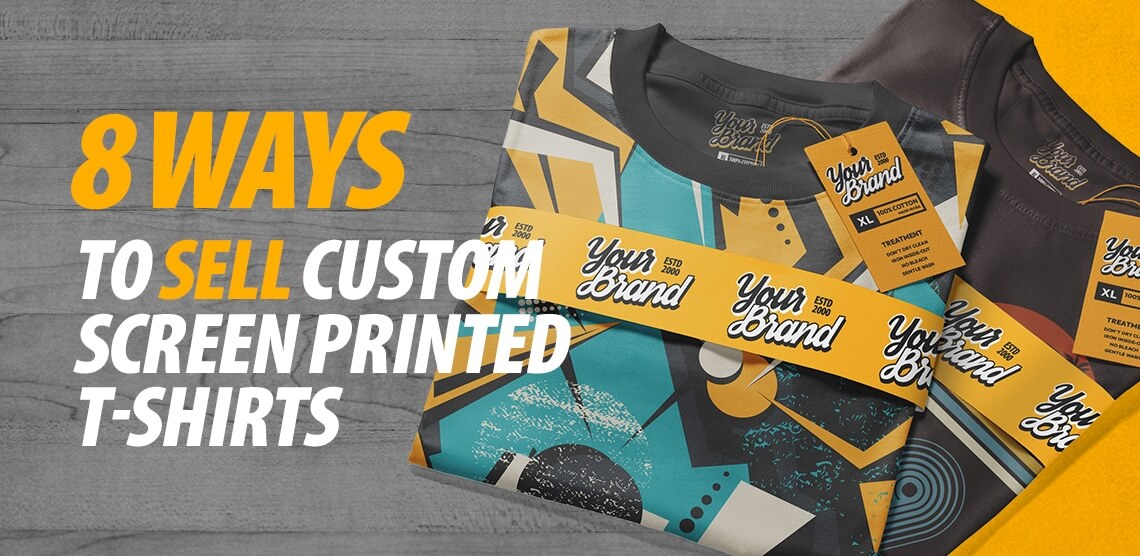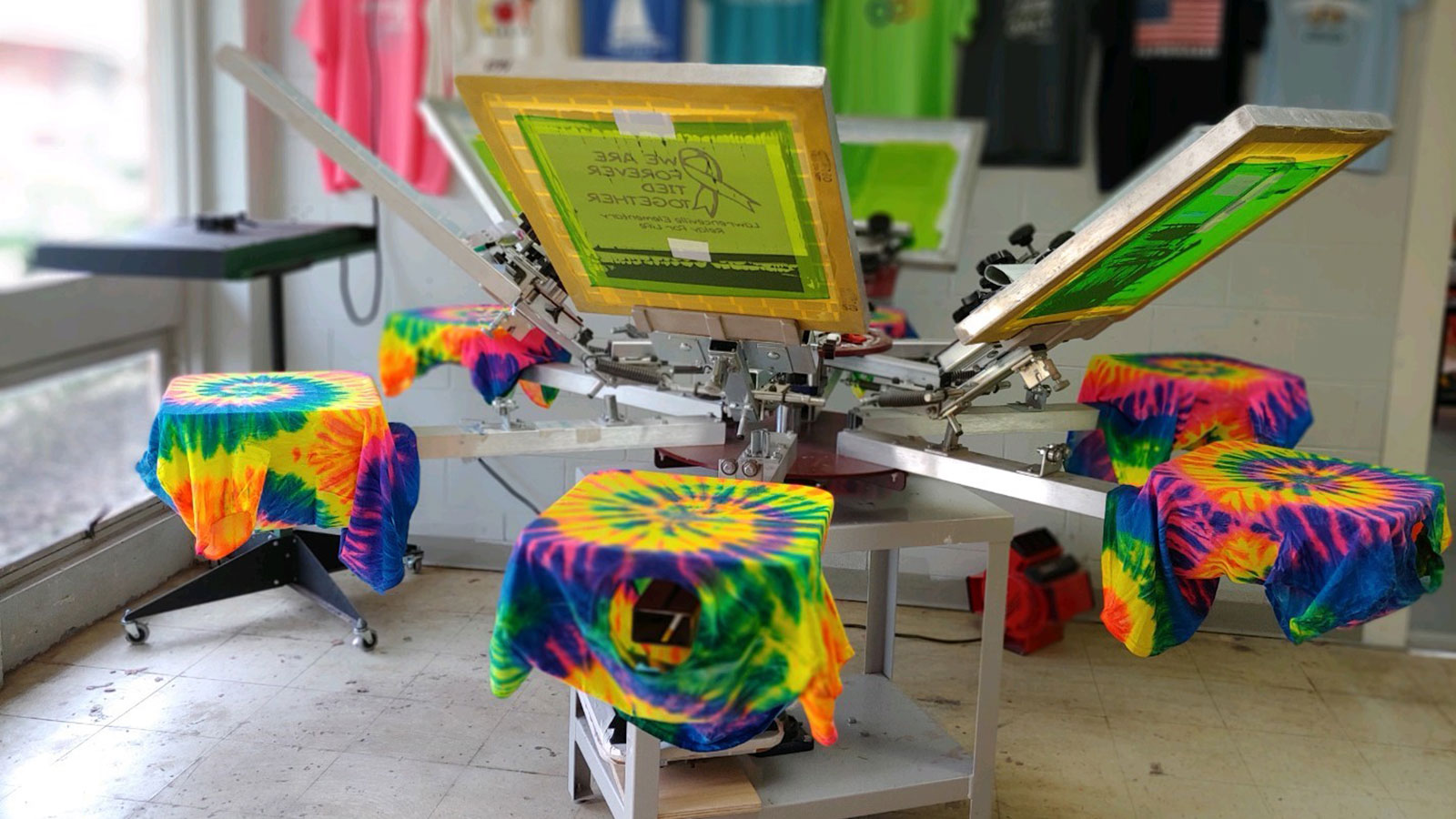Durable T-Shirt Printing for Everyday Wear
Durable T-Shirt Printing for Everyday Wear
Blog Article
Display Printing Uncovered: Every Little Thing You Need to Learn About Tee and Garment Printing Methods
If you have actually ever before wondered just how those dynamic designs wind up on your favorite t-shirts, you remain in the best area. Display printing is an interesting approach that combines art with method, providing endless opportunities for creativity. Understanding the fundamentals, from tools to ink selections, can considerably impact your results. Prepared to discover the crucial aspects that make display printing an art form? Allow's reveal the information that can raise your jobs.
The Essentials of Display Printing: Exactly How It Functions
When you dive right into display printing, you'll discover it's both a scientific research and an art. At its core, display printing involves developing a stencil, or display, that permits ink to go through only in particular locations (screen printing kit). You begin by selecting your style and preparing your screen with a light-sensitive emulsion. As soon as you reveal this solution to light, it solidifies, leaving your layout as an adverse room.
Following, you'll blend your inks and prepare your printing surface. Placement the screen over the textile, then make use of a squeegee to push ink via the screen onto the garment. This procedure needs accuracy, as you want clear, vibrant prints. After printing, you'll treat the ink with heat, guaranteeing it abides by the fabric and lasts with washes. Each step is vital, and mastering them will boost your display printing abilities, changing easy garments right into unique, meaningful items.
Kinds of Display Printing Methods
When you understand the basics of display printing, it's time to discover the various techniques that can raise your designs. One popular approach is standard screen printing, where ink is pushed via a stenciled display. This technique is terrific for vibrant, vivid shades. Then there's water-based ink printing, which provides a softer feel and is eco-friendly, however it needs a various strategy to curing.
If you're going for great information, take into consideration discharge printing. This technique removes dye from the material, leaving a soft, classic appearance. One more option is plastisol printing, known for its sturdiness and vibrant colors, making it a favored for lots of brands. Experiment with halftone printing to develop slope effects and detailed layouts. Each strategy has its one-of-a-kind beauty, so do not be reluctant to try them out to discover what suits your design best!
Essential Tools for Screen Printing
To accomplish magnificent outcomes in display printing, having the appropriate tools is fundamental. You'll need a durable screen printing framework, which holds the mesh that moves your style onto the garment. Next off, spend in high-grade squeegees; these are crucial for applying ink uniformly throughout the screen.
Choosing the Right Inks and Materials
When picking inks and products for display printing, you require to take into consideration the kind of ink that functions finest for your job. Think of material compatibility to ensure your designs look excellent and last long. Discover green ink options to make your printing procedure a lot more lasting.
Types of Display Inks
Selecting the right screen ink is crucial for accomplishing vibrant, resilient prints that meet your project's demands. There are several sorts of display inks to take a look at. Plastisol ink is preferred for its versatility and convenience of use, offering excellent shade opacity on dark materials. Water-based ink, on the various other hand, supplies a softer feeling and is environment-friendly, making it excellent for those aiming to reduce their environmental effect. Discharge inks get rid of dye from the textile, leading to a soft, vintage look but need specific handling. Specialized inks, such as glow-in-the-dark or metal, can add special effects to your layouts. Assess your project demands and select the ink that straightens ideal with your preferred outcome.

Material Compatibility Considerations
Understanding material compatibility is essential for accomplishing premium display prints, particularly because different materials react distinctly to various inks. When picking inks, think about the material kind-- cotton, polyester, or blends. For cotton, water-based inks function well, providing softness and breathability. Polyester, on the various other hand, usually calls for plastisol inks for much better adhesion and vibrant shades. If you're publishing on blends, you might require to utilize a combination of both kinds. Constantly examine your inks on example textile to assure they stick effectively and preserve shade honesty. Furthermore, keep in mind that textile weight and appearance can influence the final end result, so choosing the ideal ink and product combo is vital for your task's success.
Eco-Friendly Ink Options
Environmentally friendly inks are ending up being a prominent option for display printers that wish to decrease their environmental influence while maintaining top quality. When choosing inks, think about water-based inks, which are less unsafe and simpler to cleanse up contrasted to conventional solvents. These inks bond well with textiles, supplying vibrant outcomes without poisonous chemicals. You might also check out eco-solvent inks that make use of fewer unpredictable natural compounds (VOCs), making them a much safer alternative for both your health click here for more info and the planet.
Additionally, look for inks made from eco-friendly resources, such as soy or vegetable-based choices. By choosing the right inks and materials, you'll not only develop stunning styles however additionally add to a much more sustainable printing process. Make the switch, and your prints will mirror your dedication to the setting!
Preparing Your Layout for Display Printing

Submit Style Requirements
To assure your design looks lively and sharp on textile, you'll require to pay close focus to submit layout needs for display printing. Make certain your style has a clear history to protect against unwanted white sides on your prints. Maintain color modes in mind; CMYK is common for display printing, so transform your RGB designs as necessary.
Color Separation Strategies
Color separation is a crucial action in preparing your design for display printing, and mastering it can considerably enhance your print high quality. You'll need to damage your layout into private shades, as each color needs a different check this site out screen during printing. Begin by recognizing all the colors in your style and produce layers each. You can utilize software application like Adobe Photoshop or Illustrator to isolate and separate shades successfully. Be specific to save each layer as a separate documents, commonly in a layout like TIFF or PSD. This precision not only guarantees accurate shade depiction however likewise improves the printing process. By taking notice of shade splitting up, you'll attain professional and dynamic results in your screen-printed garments.
Resolution and Dimension
Accomplishing the ideal cause display printing starts with ensuring your layout has the best resolution and dimension. Ideally, your artwork needs to be at the very least 300 DPI (dots per inch) for sharp, clear prints. Your last product might look pixelated and unprofessional. if you use lower resolution.
When it involves size, consider the dimensions of your print area. Style your artwork to match the last print dimension, ideally developing it in the actual measurements you'll be publishing. This method, you'll avoid any type of unexpected scaling concerns.
Always inspect your layout in both vector and raster layouts. Vector graphics can be scaled without shedding quality, making them optimal for screen printing. Preparing appropriately will ensure your design looks impressive on every garment!
Step-by-Step Screen Printing Process
Display printing is a dynamic procedure that allows you to create dynamic styles on different surface areas. To start, you'll require a display, solution, and your picked ink. Prepare your display by cleansing it extensively. Next, apply the emulsion evenly and let it completely dry in a dark location. As soon as dry, subject your display to light with your layout placed on it, which will solidify the emulsion where the light hits, developing a pattern - screen printing kit.
Pour ink onto the screen and use a squeegee to press the ink with the pattern onto the material. Raise the display very carefully and let the print completely dry. You've successfully display printed your layout.
Tips for Effective Screen Printing Projects
While YOURURL.com you're diving right into your screen printing projects, bear in mind that prep work is essential to success. Start by collecting all your materials-- inks, garments, squeegees, and displays. A tidy work space helps prevent undesirable errors, so clean prior to you start.
Next, validate your art work is high-resolution and properly sized for your garment. Test your display for correct direct exposure and tidy it extensively to stay clear of spots. When blending your inks, follow the supplier's standards to achieve the right consistency.
During printing, use also pressure with your squeegee for constant results. Do not hurry; take your time to confirm each print fulfills your requirements. After printing, let your garments completely dry totally before taking care of or packaging them.
Lastly, always maintain an example of your work for future referral. This method, you can analyze your progression and improve your strategies over time. Satisfied printing!

Regularly Asked Inquiries
The length of time Does It Require To Establish up a Display Printing Task?
Establishing a screen printing task normally takes about half an hour to an hour. You'll prepare the displays, mix inks, and change the press. The time differs based upon complexity and experience, so stay arranged!
Can I Publish on Different Fabric Types Making Use Of the Very Same Method?
Yes, you can print on different textile kinds utilizing the exact same method, but you'll need to readjust your inks and setups. Some textiles take in ink in different ways, so experimenting guarantees the very best outcomes for every material.
What Prevail Errors to Prevent in Screen Printing?
When display printing, prevent common mistakes like making use of the wrong ink, overlooking proper direct exposure times, or skipping pre-press checks. Always examine your arrangement and keep tidy screens to assure top quality results each time.
Exactly How Can I Correctly Tidy and Keep My Screen Printing Equipment?
To properly tidy and keep your display printing tools, you need to routinely clean displays with proper solvents, inspect mops for wear, and assure all devices are stored completely dry and dust-free. Uniformity avoids pricey repair work and improves performance.
Is Display Printing Eco-friendly Contrasted to Other Techniques?
Display printing can be more eco-friendly than other techniques, specifically if you use eco-conscious products and water-based inks. By picking sustainable materials and techniques, you minimize waste and minimize your influence on the planet.
Display Printing Uncovered: Everything You Need to Know Regarding Tee and Garment Printing Methods
At its core, display printing involves producing a stencil, or display, that allows ink to pass with just in specific areas. Placement the screen over the material, then make use of a squeegee to push ink via the display onto the garment. One preferred technique is traditional screen printing, where ink is pressed through a stenciled screen.When picking inks and materials for screen printing, you need to take into account the type of ink that functions ideal for your job.
Report this page